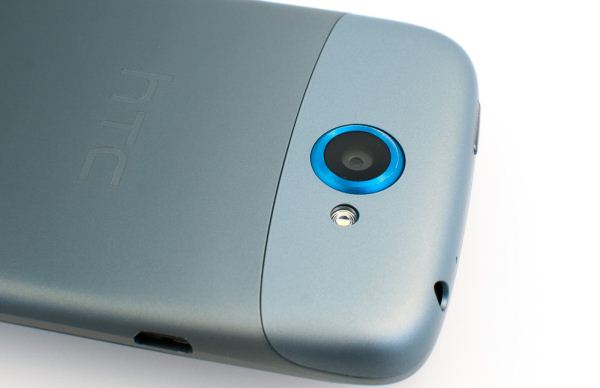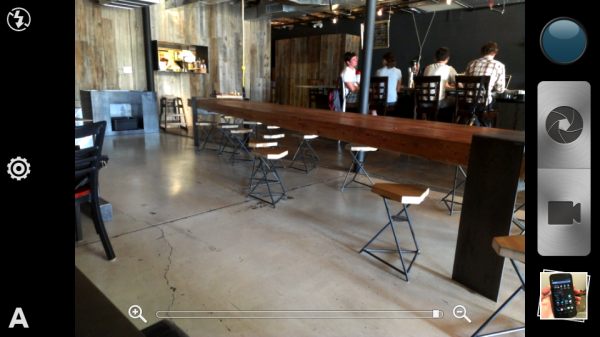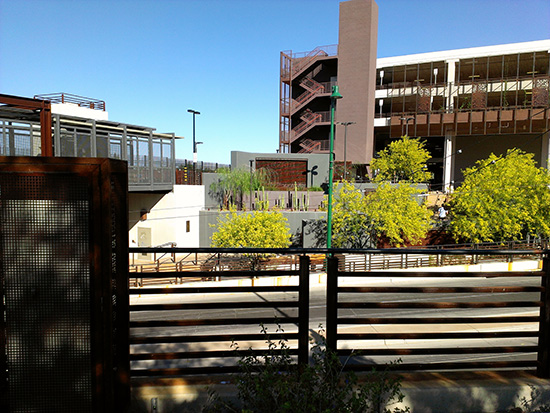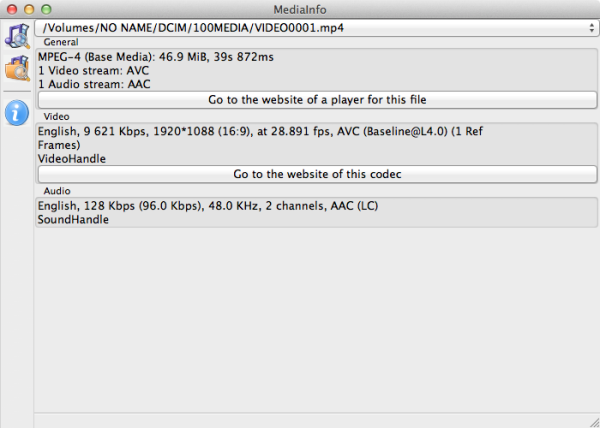HTC One S Review - International and T-Mobile
by Brian Klug on July 17, 2012 9:30 AM ESTWith the One series, HTC has done quite a bit to guarantee as little variance in camera performance as possible between the One XL, One X, One S, and One V. Each shares a combination of the same optics, discrete ISP, and CMOS sensor (except the One V, which includes a 5MP CMOS sensor). The result is a much more focused and consistent camera experience across a wide variety of hardware. Getting good smartphone camera performance is really a function of two big things. One is the entire image chain, from the camera optics to CMOS sensor to ISP (Image Signal Processing) to the SoC bits, and finally camera software. This is the shipped, relatively immutable hardware combination if you will.
The second part is OEM characterization of how this unique combination of components behaves, and correction applied either on the ISP or in software. Things like removal of lens shading (either vignetting or chromatic, both of which I just know you’re going to add back in with Instagram), geometric distortion from imperfect optics, and whatever other correction sliders the ISP and CMOS afford you for tweaking things like sensor gain from onboard amplifiers.
By moving to as few combinations of that system as possible with ImageSense and ImageChip (referred to internally as RawChip), HTC is able to really optimize and squeeze every bit of performance out of their hardware. With the exception of the HTC One V (which contains a 5 MP CMOS but the same optics), all of the other HTC Ones I’ve taken a look at contain the same set of hardware for the rear facing camera.
To spell it out explicitly, the One S contains a Samsung S5K3H2Y 8 MP 1/3.2-inch CMOS sensor with 1.4µm square backside illuminated pixels. On top of that CMOS sensor is an optical system which I believe is 5P (5 plastic elements) with an effective focal length of 3.6mm (28mm equivalent in 35mm-land) and F/2.0 aperture. This is also the same optical system in all of the HTC Ones. This is at present the fastest optical system on paper, but of course there’s always more to a system than just specifications.
After the CMOS in HTC’s image processing chain is their ImageChip ISP which, as I outlined in the One X AT&T review, handles 3A (Autofocus, Autoexposure, and Auto whitebalance) as well as other tasks such as driving the LED flash and enabling instant capture. It’s the same RawChip ID as the other HTC Ones I’ve reviewed as well, and serves the rear facing camera. Still images on the rear facing 8 MP camera are stored at 3264 x 2448 and weigh in at around 2.5 - 3 MB depending on features. Again, this is the same camera that we’ve already reviewed on the HTC One X (MSM8960 - AT&T).
Where the HTC One S (and the One series in general) differs is the front facing camera. In the case of the One S, this system is a VGA Micron MT9V113 CMOS sensor 1/11-inches in size with 2.2µm pixels. This is lower than the 1.3 MP camera that ships on the One X / XL, but still good enough for most everything you’d do with a front facing camera right now anyway.
The camera UI on the HTC One S is exactly the same as it was on the rest of the One series, as it should be. In fact, now that I have the HTC One V I can safely say that this device also has the same exact camera UI, which means a nice consolidation across the HTC One series has indeed taken place.
That includes the ability to capture HDR images or switch through a few shooting modes by tapping on the “A” (for Automatic, default) mode at bottom left. Tapping on settings brings up the familiar options page where you can change your still image resolution, video resolution, as well as respective options. HTC continues to ship with the phone shooting in 16:9 by default (as opposed to 4:3) thus cropping away some of the image that’s being formed on the sensor. I can understand why they’re doing this (the preview canvas is 16:9) but I continue to turn this off first thing since I want the full frame of view and full area of the sensor.
The entire One series also leverages HTC’s ImageChip to enable instant image capture with a fast tap or a burst shooting mode if you hold the capture button down. This works just as well on the HTC One S as it does on either of the HTC One Xes (T3 or MSM8960). The UI also includes tap to focus / expose functionality and what appears to be a native resolution image preview.
Because the One S International and One S T-Mobile contain the exact same camera system, I only took samples with the One S T-Mobile. In fact even this is really redundant, as the One S (T-Mo / International), One X (AT&T - MSM8960) and One XL should perform identically based on the combination of same CMOS sensor, HTC F/2.0 optics, ImageChip, and MSM8960/MSM8260A’s ISP. Even though ImageChip handles much of the pipeline, the SoC ISP still gets interfaced with for some of the last stages, to the best of my knowledge. For that reason, the One X (T3) performs slightly different and the One V varies in both SoC (MSM8255) and CMOS sensor.
All that aside, to evaluate still image quality on the HTC One S, I turned to our usual combination of tests taken at our bench locations (3–7 remain available), lightbox tests with the lights on and off, and some test charts (ISO12233, distortion grid, and color checker).
I come away from the HTC One S just as impressed as I was with it on the One X AT&T. Still images are impressively sharp in the lightbox with the lights on and in the ISO12233 chart. With the lights off and the flash on, the One S does a great job thanks to the multi-level LED flash. Distortion is nicely controlled as well, just like I saw with the One X. HTC also resists the temptation to use a sharpening kernel, so there are no ugly halos around text or high spatial resolution features.
Taking the controlled photo samples and looking at image quality is one thing, and while those photo samples usually tell me almost everything I need to know, actually using a camera day to day is something else. I’ve had enough time with the One S to take plenty of miscellaneous photos, and I came away very impressed with the overall camera experience. The camera is responsive, instant capture works, the live preview is high resolution and doesn’t drop frames, settings don’t glitch out or fail - all of those things combine to either make or break a shooting experience.
I didn't talk about the HDR modes previously, which work on all of the HTC One cameras. Like in other implementations, three exposures are merged together computationally to create one image with what looks like more dynamic range. I captured a few examples and did my best to remain still, and threw together a few rollovers.
HDR mode on the HTC One series works well, although it does occasionally produce goofy colors outside and frequently makes big halos around high frequency features and edges. This is very visible if you look at the sky and parking garage boundary in the second rollover. That's something I've seen from a number of algorithms in my short time being down and dirty with image processing. As an aside, now that we have smartphones doing HDR merges, how long until we get temporal high resolution image fusion (eg. merging multiple images of the same exposure together into one very high resolution image).
Last but not least, the combination of F/2.0 and 1.4µm pixels makes it possible to have some relatively shallow depth of focus which in turn yields some background bokeh. It isn’t the extremely narrow F/2.0 you’d expect from a DSLR (depth of field is a function of pixel size in addition to just F/#, also we're already using smaller pixels than we can resolve) but the in focus region can indeed be 3–5 cm or so up close (and thus things outside that region are out of focus). If you can tap to focus and get close enough you can pull this feature out, but it definitely feels a bit more pronounced here.
This isn't Nokia PureView 808 level camera performance, but HTC has definitely secured a place in the top five, at least in my mind. Among the likes of the iPhone 4S, SGS3, and PureView.
Video
The One S captures 1080p30 video at 10 Mbps H.264 baseline with 1 reference frame, audio alongside is stereo AAC at 128 kbps. I noted this in the HTC One X AT&T review, but I would still like to see higher bitrate for baseline, or better encode parameters to get quality a bit higher. It's confusing since some of the other OEMs are shipping phones that use the same encoder but with much better parameters.
The One S also includes electronic image stabilization, and gives you the option of turning it off in the camera menu settings if the effect isn’t to your liking. There’s also a checkbox for recording audio in stereo, though I don’t know why anyone would use mono in this situation. Front facing video is VGA at just below 1 Mbps and 15 FPS, H.264 baseline, with the same audio parameters.
Rear video quality looks good, but the One S video I captured has a number of obvious dropped frames, which is unfortunate. I haven’t seen that on the One X, so I’m not entirely sure what the problem is, but obviously the encoder is struggling here for some reason. As usual I’ve uploaded the video to both YouTube and our servers for you to download and view without the transcode.
































































97 Comments
View All Comments
Brian Klug - Tuesday, July 17, 2012 - link
I have to admit I didn't try WiFI Calling, partly because on my prepaid plan WiFi calling is unsupported. I haven't had issues with WiFi in general, but then again WiFi calling does require a different QoS to be pleasant than the typical web browsing use case I stress on WiFi.-Brian
millerduck - Wednesday, July 18, 2012 - link
Thanks for the reply Brian.I have exchanged this phone once and have also been pushed the OTA update without any change in performance. I am hoping another update may be in the works to resolve the issues.
WiFi itself does seem to work fine. If there is a way to add WiFi calling tests to these reviews that would be very helpful as it is a huge selling point on the T-Mobile network.
MD
Zoomer - Thursday, July 19, 2012 - link
What does WiFi calling have to do with the carrier?It's just data to your favorite sip provider, no?
BoloMKXXVIII - Tuesday, July 17, 2012 - link
I find the trend of omiting a microSD card slot disturbing. I have about 8 months left on my current contract and I am hoping there are some quality phones left that still have a microSD card slot by the time I am ready to replace my current phone (HTC Inspire 4G).Johnmcl7 - Wednesday, July 18, 2012 - link
I very much agree and I'm baffled as to why reviewers seem ok with it, I think it's a bit of a joke to have a very powerful phone capable of HD video recording, HD screen and capable of increasingly fancy games with a measly 16GB of a memory and no expansion. I thought it was poor that the slot was removed on the Galaxy Nexus but assumed it would get hammered for it in reviews so no-one else would follow suit but that slipped past and now HTC are at it which again seems fine in this review - I view it as a big plus that the S3 still has micro SD yet that doesn't even get a mention in the verdict. What is the point of having all this fancy hardware if it's crippled by a lack of memory? 16GB is really nothing by the time you've loaded a few games, HD films, music and started taking advantage of the HD recording. Yes you can stream data but data caps seem to be getting increasingly tight at the moment, you need decent reception and it uses considerably more batterypower plus a device with a micro SD card slot can do all that as well if needed.The S3 keeping its micro SD slot is a good sign and I hope that's the way Samsung stay despite others removing the micro SD slot. I also hope they keep the removable battery as that's also something I find increasingly handy, my phone's battery life is pretty good on idle but games and web browsing quickly hammer it but I don't need to worry about that because if I kill the battery I can swap it straight over to a fully charged one without issue rather than the fiddle of trying to charge it on the move with a portable battery charger.
John
OCedHrt - Tuesday, July 17, 2012 - link
The One S's stock browser has an inverted browsing mode - however things I've read on forums (XDA etc) seem to indicate this doesn't really improve battery life.JFish222 - Tuesday, July 17, 2012 - link
I, like so many, am trying to decide between the S3 vs One/Evo/etc (I'm on Sprint.)I prefer the HTC's in hand feel but am looking for other ways to differentiate (that damn 2GB of RAM on the S3 makes it so much hard to go w/ the HTC!)
Can you please include the S3's in the speaker volume tests?
Great Article!
Impulses - Wednesday, July 18, 2012 - link
2GB RAM on the SGS3 and a removable batteryVs
Physical camera button, kickstand, and a slightly better display on the EVO LTE
I opted for the latter because I prefer Sense over Touchwiz and I rarely used the extra batteries I had in the past (with both previous flagship EVOs), they were nice to have when traveling but an external USB battery pack has it's own advantages (no rebooting to slap the battery in) and works well for traveling purposes (throw phone in bag and let it charge while I sleep/move between gates).
The kickstand and camera button are just things I'll get much more use out of. Had the Sprint SGS3 bring able to roam globally like Verizon's version I might've gone the other way tho.
This might be my first two year phone in a while I think, barring any uptick in my travel plans. :p (or a massive failure on Sprint's part to stick to their Network Vision & LTE deployment schedule in Puerto Rico)
TareX - Tuesday, July 17, 2012 - link
Also, AMOLED consumes close to twice more power when displaying the predominantly white screen of web browsers compared to LCDs.Mumrik - Tuesday, July 17, 2012 - link
We're calling 4.3" device diminutive now?What the hell? Let's get real - that's a pretty massive phone. 4" is already biggish.